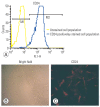The Anti-Inflammatory and Cytoprotective Efficiency of Curvularin, a Fungal Macrolactone against Lipopolysaccharide-Induced Inflammatory Response in Nucleus Pulposus Cells: An In Vitro Study
- PMID: 32252191
- PMCID: PMC8055453
- DOI: 10.31616/asj.2019.0285
The Anti-Inflammatory and Cytoprotective Efficiency of Curvularin, a Fungal Macrolactone against Lipopolysaccharide-Induced Inflammatory Response in Nucleus Pulposus Cells: An In Vitro Study
Abstract
Study design: Developing an in vitro model for assessing the anti-inflammatory properties of curvularin.
Purpose: To evaluate the efficacy of natural fungal macrolactone as a therapeutic drug against lipopolysaccharide (LPS)-induced inflammation in primary human nucleus pulposus cells (NPCs) in vitro.
Overview of literature: Lumbar disk disease is a common cause of lower back pain (LBP) and sciatica. It is an established fact that inflammation, rather than mechanical compression on the nerve root, plays a role in the cause of LBP and sciatica. Current treatment options for reducing inflammation are either nonsteroidal anti-inflammatory drugs or steroids, prolonged use of which can potentially lead to adverse effects such as gastrointestinal disturbances and renal and cardiac issues. Hence, there is a need for better antiinflammatory drugs with no or minimal complications for treating inflammation-induced LBP and sciatica. Curvularin (Cur), a fungal macrolactone, is known for its anti-inflammatory activity, but nothing is known about its impact on inflammation due to disk pathologies.
Methods: Primary NPCs were cultured and characterized by flow cytometry and immunocytochemistry using the CD24 antibody and treated with 10 μg/mL LPS for 36 hours and then treated with Cur, betamethasone, and dexamethasone (10 μg/mL) for 48 hours, after which cell cycle analysis, cell viability assay, and gene expression studies (quantitative polymerase chain reaction [PCR] and quantitative real-time-PCR) were conducted. The NPCs treated with Cur downregulated the expression of pro-inflammatory cytokines (tumor necrosis factor-α, interleukin [IL]-1β, and IL-6); matrix metalloproteinases (MMPs; MMP-2 and MMP-3), ADAMTS; and apoptotic marker (cytochrome c).
Results: In our study, Cur-treated cells showed enhanced expression of collagen 9A1 and insulin-like growth factor receptor 1, indicating the recovery of NPCs from inflammatory assault.
Conclusions: Based on observations, the anti-inflammatory properties of Cur render it an excellent drug molecule for treating disk degeneration nonsurgically, by direct injection into spinal disks when treating LBP and sciatica.
Keywords: Curvularin; Cytokines; Inflammation; Intervertebral disc degeneration; Lipopolysaccharide; Macrolactone; Nonsteroidal anti-inflammatory drugs.
Conflict of interest statement
No potential conflict of interest relevant to this article was reported.
Figures







Similar articles
-
Evaluation of Anti-inflammatory and Regenerative Efficiency of Naringin and Naringenin in Degenerated Human Nucleus Pulposus Cells: Biological and Molecular Modeling Studies.Asian Spine J. 2019 Dec;13(6):875-889. doi: 10.31616/asj.2019.0073. Epub 2019 Oct 4. Asian Spine J. 2019. PMID: 31575107 Free PMC article.
-
The Paracrine Effect of Degenerated Disc Cells on Healthy Human Nucleus Pulposus Cells Is Mediated by MAPK and NF-κB Pathways and Can Be Reduced by TGF-β1.DNA Cell Biol. 2017 Feb;36(2):143-158. doi: 10.1089/dna.2016.3230. Epub 2016 Dec 22. DNA Cell Biol. 2017. PMID: 28005398
-
Naringin Protects Against Interleukin 1β (IL-1β)-Induced Human Nucleus Pulposus Cells Degeneration via Downregulation Nuclear Factor kappa B (NF-κB) Pathway and p53 Expression.Med Sci Monit. 2019 Dec 25;25:9963-9972. doi: 10.12659/MSM.918597. Med Sci Monit. 2019. PMID: 31927560 Free PMC article.
-
Higenamine inhibits IL-1β-induced inflammation in human nucleus pulposus cells.Biosci Rep. 2019 Jun 28;39(6):BSR20190857. doi: 10.1042/BSR20190857. Print 2019 Jun 28. Biosci Rep. 2019. PMID: 31213577 Free PMC article.
-
Crocin exerts anti-inflammatory and anti-catabolic effects on rat intervertebral discs by suppressing the activation of JNK.Int J Mol Med. 2015 Nov;36(5):1291-9. doi: 10.3892/ijmm.2015.2359. Epub 2015 Sep 30. Int J Mol Med. 2015. PMID: 26648423 Free PMC article.
Cited by
-
Role of Necroptosis in Intervertebral Disc Degeneration.Int J Mol Sci. 2023 Oct 18;24(20):15292. doi: 10.3390/ijms242015292. Int J Mol Sci. 2023. PMID: 37894970 Free PMC article. Review.
-
Comparative Analysis of Autophagy and Apoptosis in Disc Degeneration: Understanding the Dynamics of Temporary-Compression-Induced Early Autophagy and Sustained-Compression-Triggered Apoptosis.Int J Mol Sci. 2024 Feb 16;25(4):2352. doi: 10.3390/ijms25042352. Int J Mol Sci. 2024. PMID: 38397026 Free PMC article.
-
MicroRNA-137 inhibits the inflammatory response and extracellular matrix degradation in lipopolysaccharide-stimulated human nucleus pulposus cells by targeting activin a receptor type I.Bioengineered. 2022 Mar;13(3):6396-6408. doi: 10.1080/21655979.2022.2042987. Bioengineered. 2022. PMID: 35236255 Free PMC article.
-
Drug Candidates for Autoimmune Diseases.Pharmaceuticals (Basel). 2022 Apr 20;15(5):503. doi: 10.3390/ph15050503. Pharmaceuticals (Basel). 2022. PMID: 35631330 Free PMC article. Review.
References
-
- Banala RR, Vemuri SK, Dar GH, et al. Efficiency of dual siRNA-mediated gene therapy for intervertebral disc degeneration (IVDD) Spine J. 2019;19:896–904. - PubMed
-
- Sampara P, Banala RR, Vemuri SK, Av GR, Gpv S. Understanding the molecular biology of intervertebral disc degeneration and potential gene therapy strategies for regeneration: a review. Gene Ther. 2018;25:67–82. - PubMed
-
- Le Maitre CL, Pockert A, Buttle DJ, Freemont AJ, Hoyland JA. Matrix synthesis and degradation in human intervertebral disc degeneration. Biochem Soc Trans. 2007;35:652–5. - PubMed
LinkOut - more resources
Full Text Sources
Research Materials
Miscellaneous

